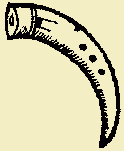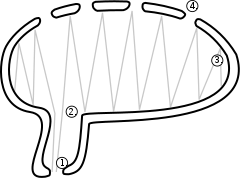Ocarina: Difference between revisions
| Line 60: | Line 60: | ||
*Reinventor of the Ocarina is one of the many titles of Hugo Rune in [[Robert Rankin]]'s ''Brentford Trilogy''. |
*Reinventor of the Ocarina is one of the many titles of Hugo Rune in [[Robert Rankin]]'s ''Brentford Trilogy''. |
||
*The classic [[Troggs]] song "Wild Thing" features an ocarina solo. |
*The classic [[Troggs]] song "Wild Thing" features an ocarina solo. |
||
*Ocarinas experienced a slight surge in popularity in the last years of the [[20th century]] due to the release of ''[[The Legend of Zelda: Ocarina of Time]]'' in [[1998]].<ref |
*Ocarinas experienced a slight surge in popularity in the last years of the [[20th century]] due to the release of ''[[The Legend of Zelda: Ocarina of Time]]'' in [[1998]].<ref name="Ocarina in C: Historical Background"/> One of the most popular [[video game|games]] for the [[Nintendo 64]], it involved the hero [[Link (The Legend of Zelda)|Link]] using a magical ocarina to change day to night and night to day, teleport all over the land of [[Hyrule]], travel through time, summon his horse, and other magical tasks. The ocarina has also appeared in several other ''[[The Legend of Zelda series|The Legend of Zelda]]'' games, such as "[[The Legend of Zelda: The Minish Cap]]". It also played quite a major role in the "sequel" game also on the [[Nintendo 64]], [[The Legend of Zelda: Majora's Mask]]. |
||
*The main character in the video game [[Growlanser II: The Sense of Justice]], named Wein Cruz, plays the ocarina to remind himself of a Growsian maiden he met when he was a young boy. |
*The main character in the video game [[Growlanser II: The Sense of Justice]], named Wein Cruz, plays the ocarina to remind himself of a Growsian maiden he met when he was a young boy. |
||
Revision as of 09:08, 21 April 2007
The ocarina (IPA: [ɑːkəˈriːnə]) is an ancient flute-like wind instrument whose origin dates back thousands of years.[1] While the standard design for an ocarina has different variations it typically includes an oval-shaped enclosed space with four to thirteen finger holes and a mouth tube that projects out from the body. It is often ceramic, but many other materials, such as plastic, wood, glass, and metal, may also be used.
History

Ancient History
The ocarina is a very old family of instruments, believed to date back some 12,000 years.[2] Ocarina-type instruments have been of particular importance in Chinese and Mesoamerican cultures. For the Chinese, the instrument played an important role in their long history of song and dance. The ocarina has similar features to the Xun, another important Chinese instrument. Different expeditions to Mesoamerica, including the one conducted by Cortés, resulted in the introduced of the ocarina to the courts of Europe. Both the Mayans and Aztecs had produced versions of the ocarina, but it was the Aztecs that brought the song and dance that accompanied the ocarina to Europe. The toy instrument went on to become popular in European communities.[3][4]
Budrio, Italy

Its common use in the Western countries dates to the 19th century in Budrio, a town near Bologna, Italy, where Giuseppe Donati transformed the ocarina from a toy, which only played a few notes, into a more comprehensive instrument (known as the first first "classical" ocarinas). The name Ocarina is derived from Italian meaning "little goose". The earlier form was known in Europe as a gemshorn; which was made from animal horns.
Budrio continues its tradition in the form of the Fabio Menaglio ocarina workshops, which produce a full range of professional instruments. Also, Budrio is home of a well-known classical ocarina group, "Gruppo Ocarinistico Budriese" (since 1865).
Recent History

In 1900 Sears, Roebuck and Company began selling ocarinas through their mail-order catalog. It soon developed its American name, the "Sweet Potato" because of its round shape and sweet sound. During World War II American soldiers were issued plastic ocarinas by the U.S. Army as a morale booster. More recent, the ocarina gained popular attention from the 1998 video game The Legend of Zelda: Ocarina of Time.[5]
Musical performance
Tone production

1. Air enters through windway
2. Air strikes edge, causing a sound
3. Air vibrates throughout inside of an ocarina
4. Covering and uncovering holes lowers and raises the pitch
The ocarina, like other vessel flutes, has the unusual quality of not relying on the pipe length to produce a particular tone. Instead the tone is dependent on ratio of the total surface area of opened holes to the total cubic volume enclosed by the instrument. This means that, unlike a flute or recorder, sound is created by resonance of the entire cavity and the placement of the holes on an ocarina is largely irrelevant—their size is the most important factor. Instruments that have toneholes close to the voicing/embouchure should be avoided, because this weakens tonal production.
The resonator in the ocarina can create overtones, but because of the common "egg" shape, these overtones are many octaves above the keynote scale.[6] In similar Helmholtz Resonator instruments with a narrow cone shape, like the Gemshorn or Tonette, some partial overtones are available. The technique of overblowing to get a range of higher pitched notes is not possible with the ocarina because of its vessel shape, so the range of pitches available is limited to a 12th. Some Ocarina makers increase the range by designing double- or triple-chambered ocarinas tuned 1 octave apart.
Different notes are produced by covering the holes, and by opening and closing more or less of the total hole area. The tone is then produced through the sound hole. The tone can also be varied by changing the strength with which one blows through the instrument (pitch bending).

Musical notation
Written music for the ocarina usually consists of a system of holes, tabulature [1],similar to the ocarina's finger hole pattern with blackened holes representing which holes should be covered. Depending on the artist, some may write a number or figure over the picture to depict how many beats to hold the note.
Types of ocarina
Multi-chambered ocarinas
Since the 19th century, many makers have produced double ocarinas able to play polyphonic pieces.
Ocarinas with keys

Ocarinas with keys have been produced by several makers, mostly experimentally, beginning in the late 19th century. Keys may be added in hopes of expanding the instrument's range, or to enable the fingers to reach holes that are widely spaced.
The modern ocarina

The ocarina makes use of a special form of tablature which represents the holes on the top of the ocarina, and, where necessary, the holes on the underside. This enables easy playing, particularly for beginners. It is similar to the tablature used for recorder and other woodwind instruments.
Appearance in works
- In the late 1930s a group of older boys began building wooden ocarinas. They formed a popular ocarina ensemble called the Potato Bugs, performing on Broadway, radio, and later television, into the 1950s. Irving Berlin wrote a popular song, inspired by them, entitled Dance to the Music of the Ocarina for the musical Call Me Madam. [2]
- The Sweet Potato Pipers, a 1930s-1940s ocarina group that toured with the Glenn Miller Orchestra, featured the ocarina, prominently on screen, in Hollywood musicals such as Girl Crazy (1943).
- A memorable part in the Bernardo Bertolucci movie 1900, set in the Emilia region of northern Italy during the early 20th century, features a scene in which a group of farmers in a forest play a tune in harmony on ocarinas of various sizes.
- An ocarina part also features prominently in the theme from the 1966 spaghetti western The Good, the Bad and the Ugly. The ocarina, along with the Jew's harp and the electric guitar, was used widely in the soundtracks of 1960s European-made westerns, to develop a distinctive style.
- The instrumental break in The Troggs's 1966 hit song "Wild Thing" contains a lively ocarina solo played by group leader Reg Presley and an ocarina is heard in the Simon and Garfunkle song "Feeling Groovie/The 59th Street Bridge song".
Ocarinas in popular culture
- Reinventor of the Ocarina is one of the many titles of Hugo Rune in Robert Rankin's Brentford Trilogy.
- The classic Troggs song "Wild Thing" features an ocarina solo.
- Ocarinas experienced a slight surge in popularity in the last years of the 20th century due to the release of The Legend of Zelda: Ocarina of Time in 1998.[7] One of the most popular games for the Nintendo 64, it involved the hero Link using a magical ocarina to change day to night and night to day, teleport all over the land of Hyrule, travel through time, summon his horse, and other magical tasks. The ocarina has also appeared in several other The Legend of Zelda games, such as "The Legend of Zelda: The Minish Cap". It also played quite a major role in the "sequel" game also on the Nintendo 64, The Legend of Zelda: Majora's Mask.
- The main character in the video game Growlanser II: The Sense of Justice, named Wein Cruz, plays the ocarina to remind himself of a Growsian maiden he met when he was a young boy.
Similar instruments
Other vessel flutes include the Chinese xun and African globe flutes. The xun (simplified Chinese: 埙; traditional: 塤; pinyin: xūn) is a Chinese vessel flute made of clay or ceramic. It is one of the oldest Chinese instruments. Shaped like an egg, it differs from the ocarina in being side-blown, like the Western concert flute, rather than having a recorder-like mouthpiece (a fipple or beak). Similar instruments exist in Korea (the hun) and Japan (the tsuchibue).
A related family of instruments is the closed-pipe family, which includes the panpipes and other instruments which produce their tone by vibrating a column of air within a stopped cylinder.
The old fashioned jugband jug also has similar properties.
See also
References
- ^ History of ocarina 2, www.ocarina-vale.com - Retrieved April 21, 2007.
- ^ Ocarina, Virginia Tech Multimedia Music Dictionary - Retrieved 2007-04-21.
- ^ History of the Ocarina, Song Bird Ocarina - Retreived 2007-04-21
- ^ A Brief History, Terry Riley Vessel Flutes - Retreived 2007-04-21
- ^ Ocarina in C: Historical Background, www.historicalfolktoys.com - Retreived 2007-04-21
- ^ Arthur H. Benade, Horns,Strings and Harmony
- ^ Cite error: The named reference
Ocarina in C: Historical Backgroundwas invoked but never defined (see the help page).
External links
- The Chuckerbutty Ocarina Quartet - British ocarina quartet, with sound samples.
- Ocarina Room - Information on making and playing, and mp3.
- Free Ocarina Sample Library
- Ocarina Festivals - Mp3 of several groups.
- Oc-Land - Fingering charts and information on ocarinas.
